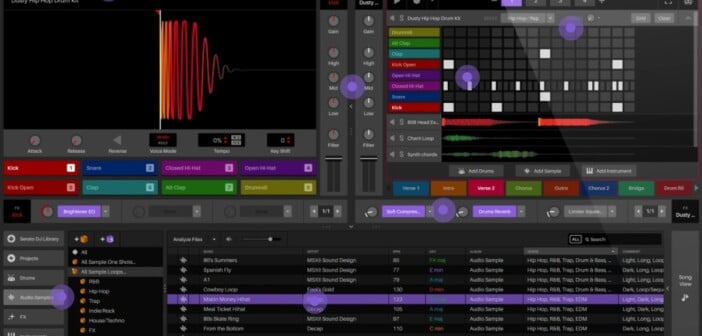Serato releases the updated Serato Studio 1.6 digital audio workstation (free), introducing audio recording, improved audio tracks, a native Virtual Audio Driver for macOS, and more.
Serato Studio is a free DAW with a unique, sample-based workflow.
Coming from Serato, the company behind renowned time-stretching and pitch-shifting plugin, Pitch ‘n Time, and sampling VST, Serato Sample, it’s no surprise that this relatively new music production platform (launched in 2019) was crafted with sample-based producers in mind.
Before we get into the latest Serato Studio 1.6 update, let’s take a closer look at the DAW itself.
Serato Studio – A beatmaker’s DAW?
During my very first session in Serato Studio, I was perplexed and inspired at the same time. The workflow was substantially different from any conventional DAW I used in the past. Nevertheless, it felt intuitive and easy to pick up without reading a manual or watching any tutorials.
Remember what it felt like to make music on a computer for the first time? You didn’t know exactly which button in your DAW did what, but I’m sure you’ve had that growing “wow” feeling in your gut as you started exploring its capabilities, recorded the first melody, added some chords, and played some drums on top.
I had that exact feeling when I picked up Serato Studio for the first time. I didn’t know exactly what I was doing, but making music with it felt natural. And this is why I think the software developers at Serato did a fantastic job at making Serato Studio the perfect DAW for both beginners and advanced beatmakers who need a change of pace from their current setup.
Serato Studio’s interface features sample pads, virtual instruments, and a step sequencer. You can build custom drum kits, sequence your drum loops and melodies, import and manipulate samples, stretch and slice audio loops, play virtual synths, add automation, import/export MIDI patterns and stems, and do most of the MIDI-related stuff you’d expect from a modern DAW.
All of this is available within a piece of software that will make home producers of all levels feel right at home.
Serato Studio also comes with some neat features that will make a beatmaker’s life easier. For example, once you set the project’s Master Key, every virtual instrument or sample you play will automatically be “in key” with the rest of your song. Another welcome feature is the flawlessly implemented 808-style drum sequencer that is simply the perfect environment for programming beats.
All that said, due to its sampling-oriented workflow, some of the audio-related features you’d expect from a contemporary DAW were still missing. However, it’s clear that Serato Studio is taking some significant steps forward in this department.
Serato Studio 1.6 – What’s new?
The new Serato Studio 1.6 allows recording audio directly into Audio Tracks, much like any standard DAW. It also implements a set of Audio Track improvements that make the audio editing workflow more intuitive and seamless.
Users now have the ability to record the incoming audio directly from any external source. This includes microphones, instruments, a vinyl deck, or even your laptop’s built-in mic.
So, you can now record some vocals over a beat or import some fresh new samples directly from your turntable.
The audio editing workflow is now more polished. Serato removed the 1-1 relationship between Audio Pads and Clips, making the audio manipulation workflow more flexible and intuitive. You can now move the Audio Clips to any Audio Track, adjust each Audio Clip’s parameters independently, fine-tune the start points, and more.
Another highlight in Serato Studio 1.6 is the new Virtual Audio Driver on macOS, which replaces the third-party driver used previously (iShowU).
Serato Studio – Do you need it?
If you’re a sample-based producer who wants to try their hand at beat-making, Serato Studio offers the perfect solution.
The software is both robust and powerful while remaining intuitive and easy to use. On the other end of the spectrum, experienced music producers looking to freshen up their workflow will probably find some new inspiration with Serato Studio’s fast workflow.
Serato Studio is also the perfect candidate for a laptop-based portable music production system.
Serato Studio has three pricing options. The free version offers one Audio Track, four Decks, four Scenes, and MP3-only audio export. The paid editions ($9.99 monthly subscription or a $199 one-time payment) have unlimited tracks and decks while adding automation, 32 total Scenes, WAV mixdown, audio stems export, and a free iZotope plugin.
More info: Serato Studio
More articles:




2 Comments
Zak
onThe DAW is compatible with Windows, but no information about Linux. Not sure why one would go out of their way to omit this information. There are more Windows users than apple users. Trying to present it otherwise does not change the reality.
Additionally, the izotope plugin is only available with the subscription – not the paid version.
The izotope plugin is Ozone 9 Elements.
The $9.99 subscription price is a temporary offer.
Serato
onHi Zak,
I can confirm you do get the free iZotope Ozone 9 Elements plugin with both the outright license or the monthly subscription.
The $9.99 per month subscription is also the standard price, this is not a temporary offer.
There’s also a free version with a limited feature set that you can use forever.